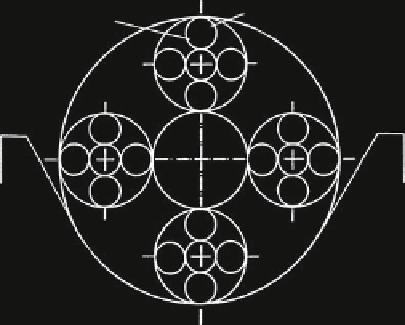Civil Engineering Reference
In-Depth Information
Fig. 3.3 Bending stresses in
the wires of an ordinary lay
rope between straight and
bent, Schiffner (
1986
)
bending stress
constant ratio of
winding angle
ˑ
/
˕
bending stress
constant
lay angle
305
371
366
468
366
468
202
250
409
346
409
346
592
592
492
615
500
615
500
492
410
351
410
351
ʱ
= 18
ʲ
= 18
r
w
= 2.0 mm
r
s
= 5.5 mm
ʴ
206
265
378
495
378
495
= 1.0 mm
D = 400 mm
325
399
stresses in N/mm
2
with
tan
u
S
2
D
2
r
S
1
2
#
¼
s
D
2
4
r
S
arctan
s
D
2
4
r
S
ð
3
:
9
Þ
tan b
0
1
1
and
h
S
h
W
cos b
0
u
W
¼ u
W0
þ
u
S
:
ð
3
:
10
Þ
For calculating either the curvature, the winding, the bending stress and the torsion
stresses of the wires in different positions are drawn in Fig.
3.3
for an ordinary lay rope
and in Fig.
3.4
for a lang lay rope. Figure
3.5
shows a very small torsion stress for an
ordinary lay rope. The upper number always shows the stress for a constant ratio of the
winding angles
#
/u
S
and the lower number shows the stress for a constant lay angle b.
In the example chosen, the global bending stress according to Reuleaux is
500 N/mm
2
. If the bending stress is calculated more precisely, it is both larger and
smaller than that in the various positions. In any case, the maximum bending stress
occurs laterally in the neighbourhood of the core. For a constant strand lay angle,
this bending stress is just the same as the bending stress according to Reuleaux.
For the constant ratio of the winding angles
#
/u
S
, this bending stress is 23 %
greater for ordinary lay ropes and 18 % greater for lang lay ropes. At the bottom of
the groove, the bending stress of the wires is relatively small. For ordinary lay
ropes it is 325 resp. 399 N/mm
2
and for lang lay ropes 199 resp. 255 N/mm
2
.






Search WWH ::

Custom Search